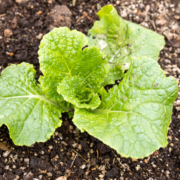Apply Mulch Now for Benefits all Season
Spring is almost here — only eight more days! We are itching to get our hands dirty in the garden.
Never do we appreciate the richness of the soil or the sunshine more than at the start of spring. Plus, our garden seems just as happy to see us.
During these first few weeks, we set ourselves up for success in the season ahead.
And one of the first items on the to-do list is laying a new bed of mulch. Not only does it look great and make your neighbors envious, but mulch provides a world of benefits!
Organic mulch can reduce water use in the garden by 25-50 percent, which saves money on water bills and conserves water. A thick blanket of mulch reduces evaporation, so you don’t have to water as much. Mulch also controls weeds. Plus, your flower beds look polished and complete with a finishing touch of mulch.
Best of all, organic mulch improves soil health as it decomposes throughout the season.
To reap these benefits, mulch has to be organic.
While non-organic mulches, such as plastic film and rubber, are cheaper, they cause major problems later. Inorganic mulches do not break down over time, so they don’t condition the soil. Even worse, they begin to block air and water from plants’ roots. Nine out of ten times, you’ll need to remove non-organic mulches by hand later.
Natural mulches are composed of plant matter and are very popular. From wood chips and pine needles to shredded bark, pick the organic mulch you like best. These mulches decompose over time which helps improve the soil but it also means they must be replaced once or twice a year.
How do you apply it? It’s easy and can be done this weekend.
First, you’ll want to lightly rake the soil to loosen up the surface. Once loose, pull any weeds or dead plant material.
Then, give your mulch the smell test. Mulch should smell woody or earthy; if mulch smells sour like vinegar, replace it entirely.
This is an ideal time to feed evergreen and acid-loving plants such as rhododendrons, azaleas, dogwoods and hollies with Holly-tone. Apply it in a circle around the drip line of shrubs or trees.
Finally, lay 2 – 3” of mulch around established plants. Mulch that’s too deep can actually smother young plants.
When mulching trees, the mulch should extend away from the plant to a little beyond the drip line covering a bit of the roots. But don’t build volcanoes! Never pile up mulch. Instead, keep 2 – 3” away from the stems of woody plants and 6 – 12” away from buildings to avoid pests.
Keep your garden healthy and your home safe this season by choosing organic mulch. Make it a priority on your spring garden to-do list.









Trackbacks & Pingbacks
[…] planting, provide beds with a fresh layer of mulch. Mulching is the perfect way to get your garden off to a great start. Not only does it help settle in the roots, but it will provide warmth, hold in moisture, suppress […]
Comments are closed.